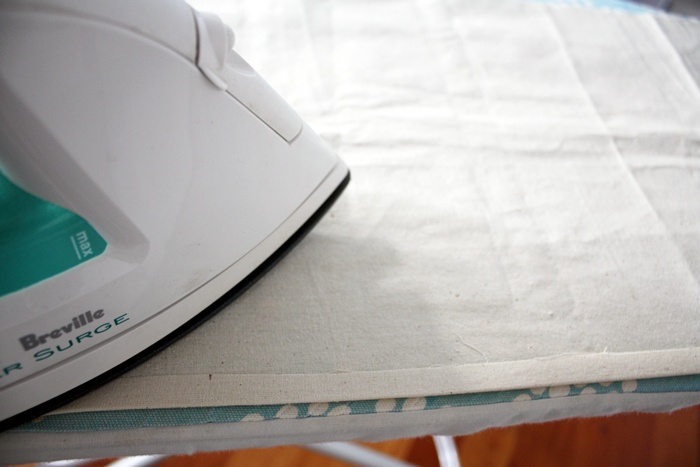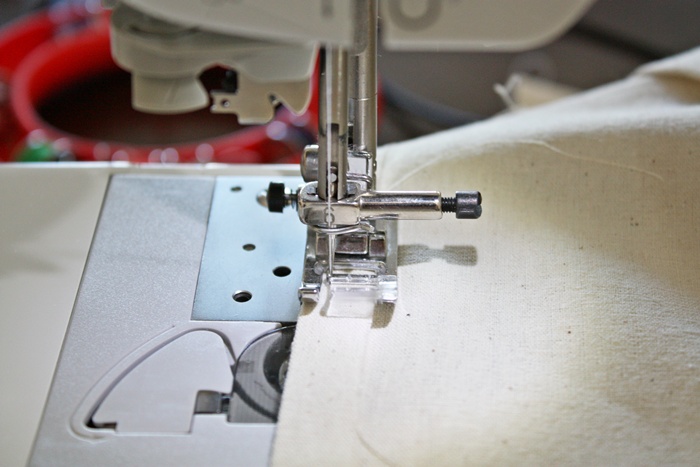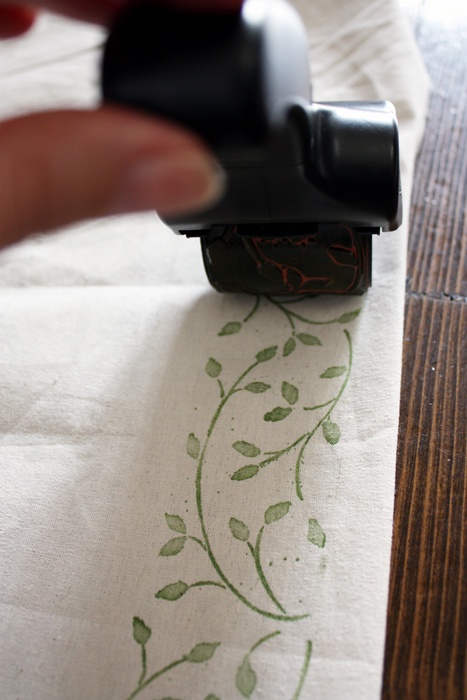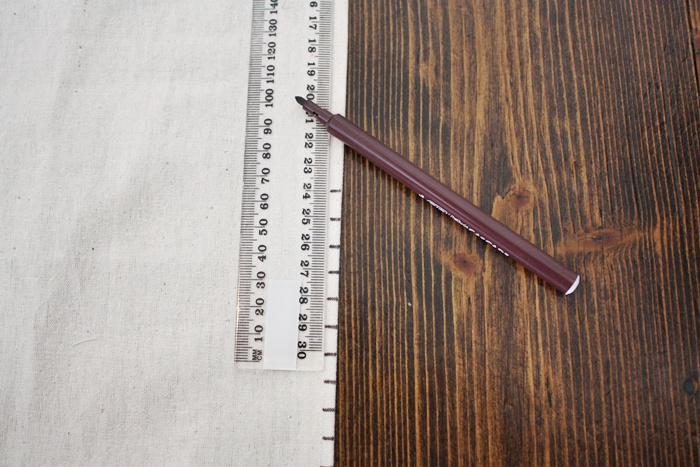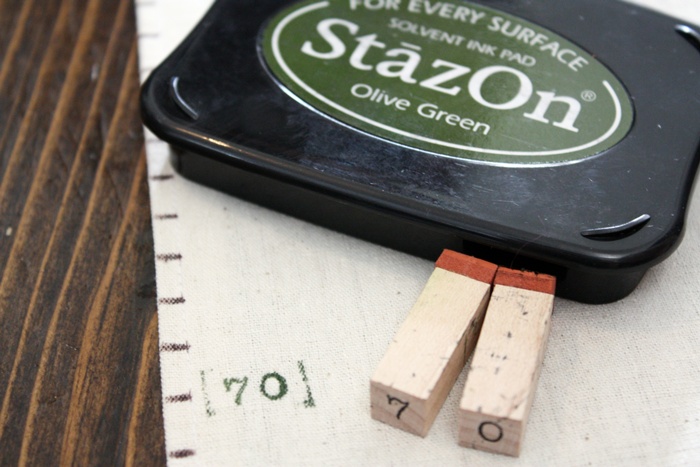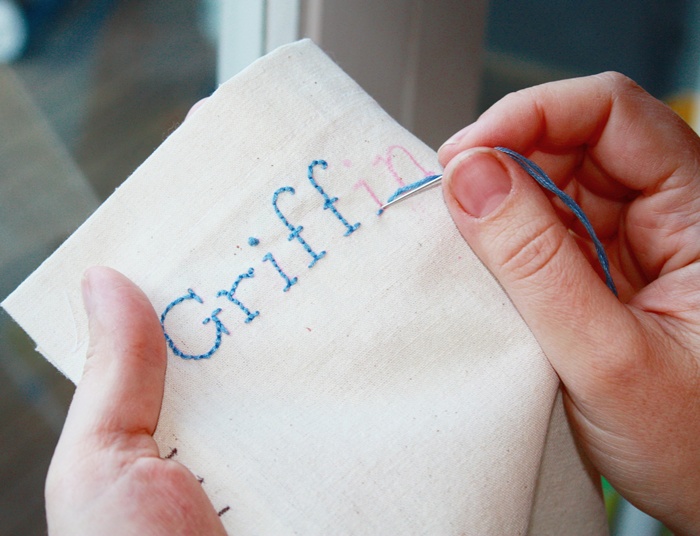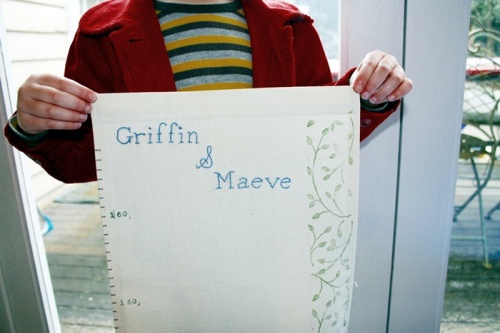A while back I showed you this height chart I made for Sophia and Olive and now I’m delighted to offer a tutorial for you to make your own.
What you’ll need:
- Calico fabric. You will need to cut your rectangle to 132 cm x 30 cm, so 140cm of calico for some fudge factor is probably what I would buy. The calico needs to be heavy enough that it will fall well when it’s hung but not so heavy that it’s stiff as a board. I wish I could give you a thread count or something but I can’t. Just feel the calico between your fingers and go with your instinct.
- Textas/felt tip pens (just normal ones are fine – they needn’t be permanent)
- Fabric scissors
- Wooden dowel: 2 pieces; each with a diameter of about 1cm and length of 34.5 cm
- Something to decorate the edge of your chart. I use a jumbo roller stamp but there are plenty of other options and I discuss some of these further on in the tutorial.
- Measuring tape or ruler
- Embroidery needle and thread
- Alphabet embroidery transfer or similar
- Embroidery transfer pencil
- Split pins
- Paper swing tags
Instructions:
1. Cut a rectangle of calico 132cm by 30cm. Fold all 4 edges in 1 cm and iron.
You’ll end up with this.
2. Sew around all four edges leaving a 1.4 inch seam allowance. Sorry to jump from metric to imperial measures but, you know, I’m just keeping you on your toes. Keeping your minds sharp. You’ll thank me when none of you descend into early dementure.
I just use the outside edge of the presser foot as my guide. If your needle is aligned to the left side, that’s just under 1/4 inch. Look, frankly anything up to 1cm is fine. Unlike tarot card reading, this is not an exact science.
3. Fold each of the short ends of the rectangle over 3cm (1 and 1/4 inch) onto the back of the chart and sew in place to create the casing for the wooden dowel.
4. Stamp your vine on to your chart.
If you’re using a jumbo roller stamp, roll it firmly and slowly up the entire right hand side using the seam as your guide. That is, don’t stamp it right to the edge or it looks unbalanced.
These jumbo roller stamps consist of a cylindrical stamp with a continuous print, an outer casing with a handle that the stamp itself clicks into that allows you to roll it and a little ink pad (housed inside the roller) that inks the stamp as it goes. They do, I must admit, rock.
However, when I made the first chart I didn’t have the casing or the stamp pad insert. So I just rolled it on the pad, then with a finger at either end I rolled it up one revolution, re-inked, rolled another revolution and so on. Not an elegant way to do it but it worked out fine.
For the chart you see at the end of this post, I used the roller casing. Can you spot the difference?
Now, don’t despair if you don’t have a jumbo roller stamp with vine motif lying around (although, frankly, all the best people do). Anyway, here are some other suggestions for decorating the right hand side that are in keeping with our “growth” theme:
Buy a traditional stamp and just repeat it up the border. Make sure it is quite wide though – 5.5 cm at least – because you do want this decoration to stand out.
Flocked trim like this that was glued or gently sewed would look great. I have this trim, that I bought in a sale, in brown, black and red and think I’ll make some charts using it in the future. It’s beautifully textural.
The not-so-great thing is I can’t recall where I bought it from. This seems somewhat similar though.
Another idea would be to use fabric paint and either free hand a vine or plant design or use freezer-paper stencilling if you wanted more precision. Here’s a freezer-paper stencil tutorial I like. You can get Freezer Paper at Spotlight.
Or search for wall stencils. There are lots on ebay and in craft stores. I think this could look great if you used fabric paint and repeated it up the side.
Or, search for flowery, vine-y fabric like this Amy Butler fabric (especially the grey passion vine – LOVE). Or this would look amazing. Anything with a growth theme would be good really. Simply sew a decent strip (by decent I mean 5.5 centimtres or so wide) up the right hand side where the stamped vine would otherwise be.
You could even embroider a vine design which I think could look incredible if you had the patience and skill. I haven’t either though I’m afraid.
A word on ink before we go on. I used StazOn ink in Olive Green for the first chart (even though it isn’t really recommended for fabric). It worked well and didn’t bleed. On this second chart, I used a Rollagraph Ink Jumbo Cartridge in Pine Green – which is one that slips inside the roller for continuous inking.
5. Now create your embroidery transfer. I used one of the alphabet templates provided in the back of the Sublime Stitching by Jenny Hart which I also recommend for anyone keen to learn the basics of broidsing.
Using everyday baking paper and an embroidery transfer pencil, trace the names remembering (VERY important) to do it backwards so when it comes time to flip it and iron on the transfer it will appear the right way.
You can also simply create your own template on your computer. But again, remember to reverse the layout so it prints back to front because after you’ve traced it you’ll be flipping it so it irons on the right way.
Otherwise, the only flipping you’ll be doing is flipping the bird to yourself for having ironed it on the wrong way. I’m speaking from bitter experience my friends. And yes, I have flipped myself the bird on occasion. But only when I’ve really deserved it. Put me straight back in my place it did too.
Right, so stop trying to see if flipping yourself the bird is even possible (I so know you are trying right now) and let’s get back to biz.
6. Iron your design gently onto your chart in a spot where it looks good and, most importantly, balanced.
7. Once you’ve ironed your name or names on, you can mark the centimetres (or inches) onto the left hand longer edge of the chart using a ruler and an ordinary texta (felt tip pen).
I can’t guarantee that these marks would survive a round in the washing machine but hopefully your chart wouldn’t get so dirty that it would ever need a wash.
If you’re concerned, you might like to track down a more permanent fabric pen to make your marks. I don’t recommend Sharpies though. They bleed. So do test anything you use first.
8. Stamp numbers every 10 increments. I used StazOn ink in Olive Green again. Remember, because your chart will hang a certain distance off the floor, the numbers on your chart are going to start around 50cm or 60cm (which are the centimetres that presumably your child has already [selfishly] grown) . The dimensions of this chart allow you to have from 60cm to almost 170cm because I think 50cm from the very bottom of the chart to the floor just looks right when it’s hung.
You will also see that I stopped my numbers at 160cm although my increments go to almost 170cm so that I didn’t crowd the embroidery.
9. Embroider the names on. For this chart I used all 5 strands of broids floss to get a nice, clear effect. A darker colour would require fewer strands of floss. Although this is kind of a personal preference kind of thing.
10. Thread your dowel through the casing at each end and then tie some string or ribbon to the top piece of dowel to create a “hanger”. I made a couple of notches on the dowel with a knife so the string wouldn’t slide.
11. Measure your kids. Get cross with them for growing too fast.
12. Use split pins to mark heights. You can just gently push the pins through the fabric or make a tiny slit with a craft knife if you prefer then slide the pin through.
13. Stamp or write details onto swing cards and tie around split pins.
Or you could write straight on your chart if you’re not as uptight about being neat as I am. I hate my handwriting so I tend to avoid that option.
14. Pat yourself on the back for a job well done (on your kids and the chart).
15. Shed a few tears because despite your best efforts to stunt them, your kids are still going to grow and, in the proverbial two shakes of a lamb’s tail, they’ll be off the chart.
16. Pour large glass red wine to console yourself. Drink.


